1996 GMC SIERRA heater
[x] Cancel search: heaterPage 74 of 404
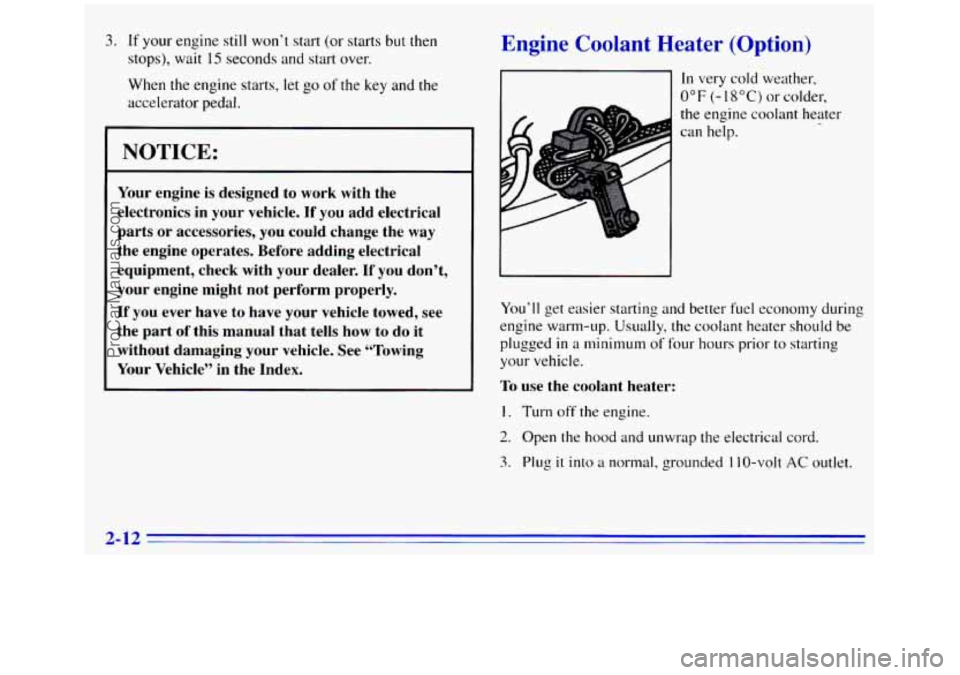
3. If your engine still won’t start (or starts but then
stops), wait
15 seconds and start over.
When the engine starts, let
go of the key and the
accelerator pedal.
I NOTICE:
Your engine is designed to work with the
electronics in your vehicle.
If you add electrical
parts or accessories,
you could change the way
the engine operates. Before adding electrical
equipment, check with your dealer.
If you don’t,
your engine might not perform properly.
If you ever have to have your vehicle towed, see
the part
of this manual that tells how to do it
without damaging your vehicle. See “Towing
Your Vehicle” in the Index.
Engine Coolant Heater (Option)
-
In very cold weather,
0°F (-18°C) or colder,
the engine coolant heater
can help.
You’ll get easier starting and better fuel economy during
engine warm-up. Usually, the coolant heater
should be
pl~~gged in a minimum of four hours prior to starting
your vehicle.
To use the coolant heater:
1. Turn off the engine.
2. Open the hood and unwrap the electrical cord.
3. Plug it into a normal, grounded 110-volt AC outlet.
2-12
ProCarManuals.com
Page 75 of 404
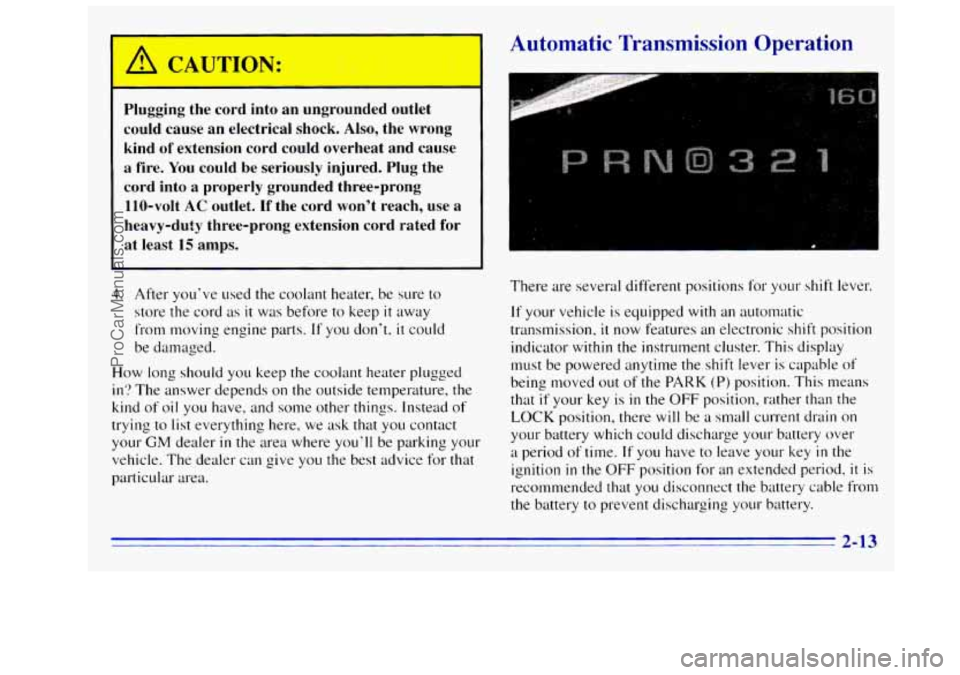
..
Plugging the cord into an ungrounded outlet
could cause an electrical shock. Also, the wrong
kind of extension cord could overheat and cause
a fire.
You could be seriously injured. Plug the
cord into a properly grounded three-prong 110-volt
AC outlet. If the cord won't reach, use a
heavy-duty three-prong extension cord rated for
at least
15 amps.
3. After you've used the coolant heater, be sure to
store
the cord as it was before to keep it away
from moving engine parts.
If you don't. it could
be damaged.
How long should you keep the coolant heater plugged
in'? The answer depends on the outside temperature, the
kind of oil you have, and some other things. Instead of
trying to list everything here, we ask that you contact
your GM dealer in the area where you'll be parking your
vehicle. The dea1e.r can give
you the best advice for that
particular area.
Automatic Transmission Operation
There are several different positions for your- shift lever.
If your vehicle is equipped with an automatic
transmission,
it now features an electronic shift position
indicator
within the instrument cluster. This display
must be powered anytime the shift lever is capable
of
being moved out of the PARK (P) position. This means
that
if your key is in the OFF position, rather than the
LOCK position, there will be a small current drain on
your battery which could discharge your battery over
a period of time. If you have to leave your key in the
ignition
in the OFF position for an extended period, it is
recommended that you disconnect the battery cable from
the battery
to prevent discharging your battery.
ProCarManuals.com
Page 132 of 404

Mode Knob Optional Climate Control System
The right knob on the control panel allows you to
choose
the direction of air delivery. The control knob
can be placed in any position between two mode settings
to blend the
flow of air.
+e
/J VENT: This setting directs air through the
instrument panel outlets.
+’ VENT/HEAT Use this setting to divide airflow
between
the floor outlets and instrument panel outlets.
+iJ HEATB; This setting directs air through the
floor outlets.
6fl DEFOG: This setting directs air to the heater
outlets and toward the windshield.
9 DEFROST: This setting directs air toward
the windshield.
+*
e
(ii3, Fan Knob
The knob on the left side of the heating system control
panel controls the fan speed. The knob has four speed
positions. To increase airflow, move the knob toward
HI. To decrease airflow, move it toward LO. To turn the
fan off, move the knob to
OFF. If you have the air
conditioner on. moving
the fan knob to OFF also turns
off the A/C compressor.
3-2
ProCarManuals.com
Page 133 of 404
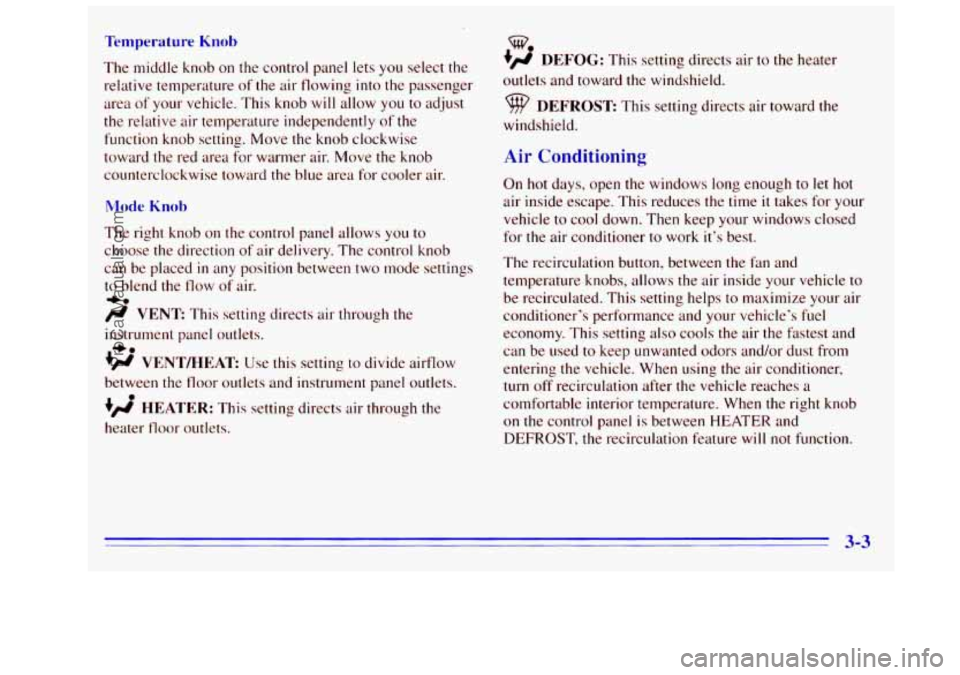
Temperature Knob
The middle knob on the control panel lets you select the
relative temperature
of the air flowing into the passenger
area of your vehicle. This knob will allow you to adjust
the relative air temperature independently
of the
function knob setting. Move the knob clockwise
toward
the red area for warmer air. Move the knob
counterclockwise toward the blue area for cooler air.
The right knob on the control panel allows you to
choose the direction of air delivery. The control knob
can be placed
in any position between two mode settings
to blend the flow of air.
/J VENT: This setting directs air through the
instrument panel outlets.
+H VENT/HEAT Use this setting to divide airflow
between the floor outlets and instrument panel outlets.
+’ HEATER: This setting directs air through the
heater floor outlets.
+e
+.
0
Qe
+’ DEFOG: This setting directs air to the heater
outlets and toward
the windshield.
DEFROST This setting directs air toward the
windshield.
Air Conditioning
On hot days, open the windows long enough to let hot
air inside escape. This reduces the time it takes for your
vehicle
to cool down. Then keep your windows closed
for
the air conditioner to work it’s best.
The recirculation button, between the fan and
temperature knobs, allows the air inside your vehicle to
be recirculated. This setting helps
to maximize your air
conditioner’s performance and your vehicle’s fuel
economy. This setting also
cools the air the fastest and
can be used
to keep unwanted odors and/or dust from
entering the vehicle. When using the air conditioner,
turn off recirculation after the vehicle reaches a
comfortable interior temperature. When the right knob
on the control panel is between HEATER and
DEFROST, the recirculation feature will
not function.
ProCarManuals.com
Page 134 of 404

The A/C button, between the temperature and mode
knobs, allows
the air coming into your vehicle to be
cooled. This setting
is useful for normal cooling on hot
days. When
you use A/C with the recirculation button
pushed
in, turn off recirculation as soon as the vehicle
reaches a comfortable interior temperature.
With the
A/C on, move the temperature knob to MAX
for maximum cooling.
This setting also puts the system
in the recirculation mode and helps
to maximize your air
conditioner’s performance and your vehicle’s fuel
economy. This setting also cools the air the fastest. After
the vehicle’s interior reaches a comfortable temperature,
move the temperature knob clockwise to place the air
conditioning system
in the normal mode.
Heating
The heater works best if you keep your windows closed
while using
it. On cold days, use the HEATER or
VENT/HEAT setting with the temperature knob in the
red area.
If you use the engine coolant heater before starting your
engine (in cold weather (20°F (-8°C) or lower), your
heating system
will produce warmer air faster, to heat
the passenger compartment
in cold weather. The
use
of an engine coolant heater also reduces the
time
it takes for the engine to reach normal operating
temperature, and shortens the time
it takes the heater to
reach full output. For more information, see “Engine
Coolant Heater”
in the Index.
Ventilation System
For mild outside temperature when little heating or
cooling
is needed, use VENT to direct outside air
through
your vehicle. Air will flow through the
instrument panel outlets.
Your vehicle’s ventilation systeril supplies outside air
to the inside of your vehicle when it is moving. With
the side windows closed, air will flow into the front
air inlet grilles, through the vehicle, and out the air
exhaust valves.
Outside air will
also enter the vehicle when the heater or
the air conditioning fan is running, unless you have
the
recirculation button pushed in. For more information on
the recirculation button, see “Air Conditioning” earlier
in this section.
3-4
ProCarManuals.com
Page 135 of 404

Ventilation Tips
Your vehicle has air outlets in the center and on the sides
of your instrument panel. You can move the outlets from
side to side or up and down to direct the
flow of air, or
close the outlets altogether. When
you close an outlet, it
will increase the flow of air coming out of any outlets
that are open. These outlets do not completely
shut off
airflow when
in the closed position.
0
0
0
Keep the hood and front air inlet free of ice, snow or
any other obstruction (such
as leaves). The heater
and defroster
will work far better, reducing the
chance of fogging the inside
of your windows.
When you enter
a vehicle in cold weather, turn the
blower fan to HI for a few moments before driving.
This helps clear the intake ducts
of snow and
moisture, and reduces the chance
of fogging the
inside
of your windows.
Keep the air path under the front seats clear
of
objects. This helps air to circulate throughout
your vehicle.
Defogging and Defrosting
On cool, humid days, use DEFOG to keep the
windshield and side windows clear.
Use DEFROST
to remove fog or ice from the windshield in extremely
humid or cold conditions. Use DEFROST
with the
temperature knob toward
the red area and the fan control
toward
HI.
ProCarManuals.com
Page 195 of 404
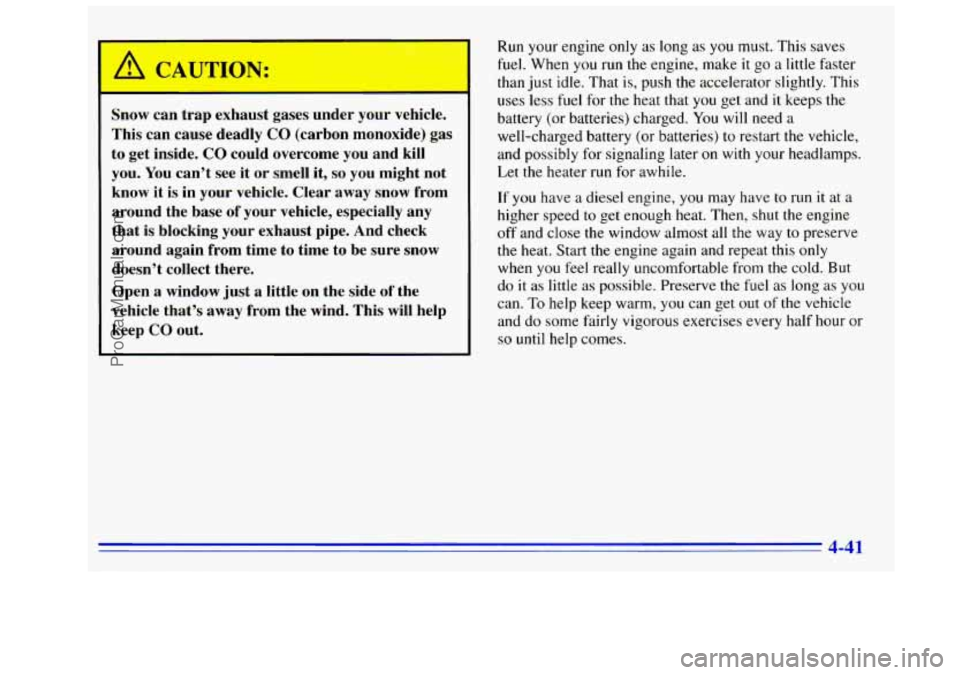
I /1 CAJTION:
Snow can trap exhaust gases under your vehicle.
This can cause deadly
CO (carbon monoxide) gas
to get inside. CO could overcome you and kill
you. You can’t see it or smell it,
so you might not
know it is
in your vehicle. Clear away snow from
around the base
of your vehicle, especially any
that is blocking your exhaust pipe. And check
around again from time to time to be sure snow doesn’t collect there.
Open a window just a little on the side of the
vehicle that’s away from the wind. This will help
keep
CO out.
Run your engine only as long as you must. This saves
fuel. When you run the engine, make it go a little faster
than just idle. That is, push the accelerator slightly. This
uses less fuel for the heat that you get and it keeps the
battery (or batteries) charged.
You will need a
well-charged battery (or batteries) to restart the vehicle,
and possibly for signaling later
on with your headlamps.
Let the heater run for awhile.
If
you have a diesel engine, you may have to run it at a
higher speed to get enough heat. Then, shut the engine
off and close the window almost all the way to preserve
the heat. Start the engine again and repeat this
only
when you feel really uncomfortable from the cold. But
do it as little
as possible. Preserve the fuel as long as you
can. To help keep warm, you can get out of the vehicle
and do some fairly vigorous exercises every half hour or
so until help comes.
4-41
~.
ProCarManuals.com
Page 227 of 404
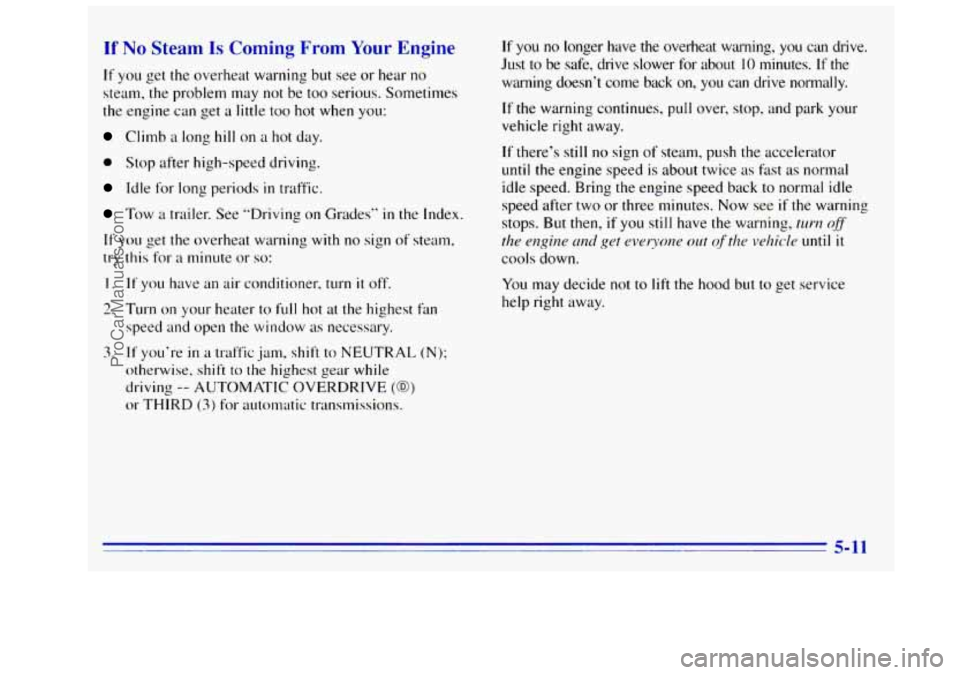
If No Steam Is Coming From Your Engine
If you get the overheat warning but see or hear no
steam, the problem may
not be too serious. Sometimes
the engine can get
a little too hot when you:
Climb a long hill on a hot day.
0 Stop after high-speed driving.
Idle for long periods in traffic.
Tow a trailer. See “Driving on Grades” in the Index.
If you get the overheat warning with no sign of steam,
try
this for a minute or so:
I. If you have an air conditioner, turn it off.
2. Turn on your heater to full hot at the highest fan
speed and open the window
as necessary.
3. If you’re in a traffic jam, shift to NEUTRAL (N);
otherwise, shift to the highest gear while
driving
-- AUTOMATIC OVERDRIVE (0)
or THIRD (3) for automatic transmissions.
If you no longer have the overheat warning, you can drive.
Just to be safe, drive slower
for about 10 minutes. If the
warning doesn’t come back
on, you can drive normally.
If the warning continues, pull over, stop, and park your
vehicle right away.
If there’s still
no sign of steam, push the accelerator
until the engine speed is about twice as fast as normal
idle speed. Bring the engine speed back
to normal idle
speed after two or three minutes. Now see
if the warning
stops.
But then, if you still have the warning, turn of
the engine nrzd get everyone nut of the vehicle until it
cools down.
You
may decide not to lift the hood but to get service
help right away.
5-11
ProCarManuals.com